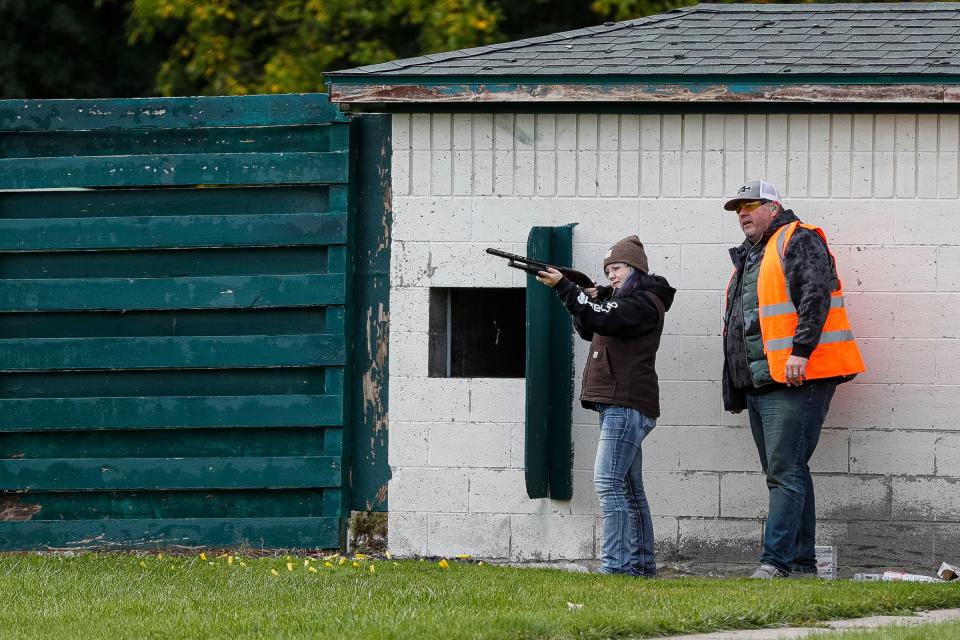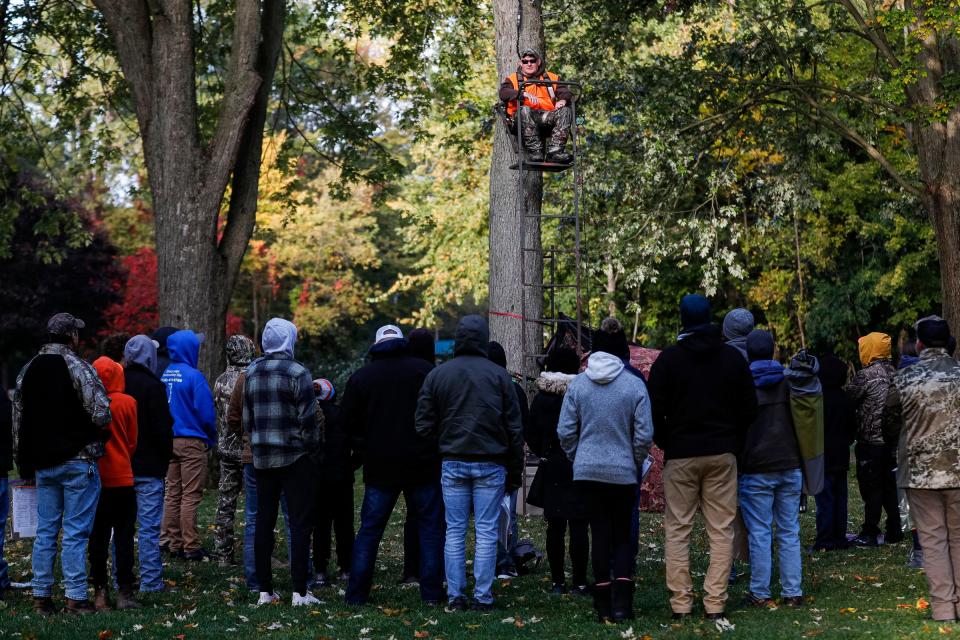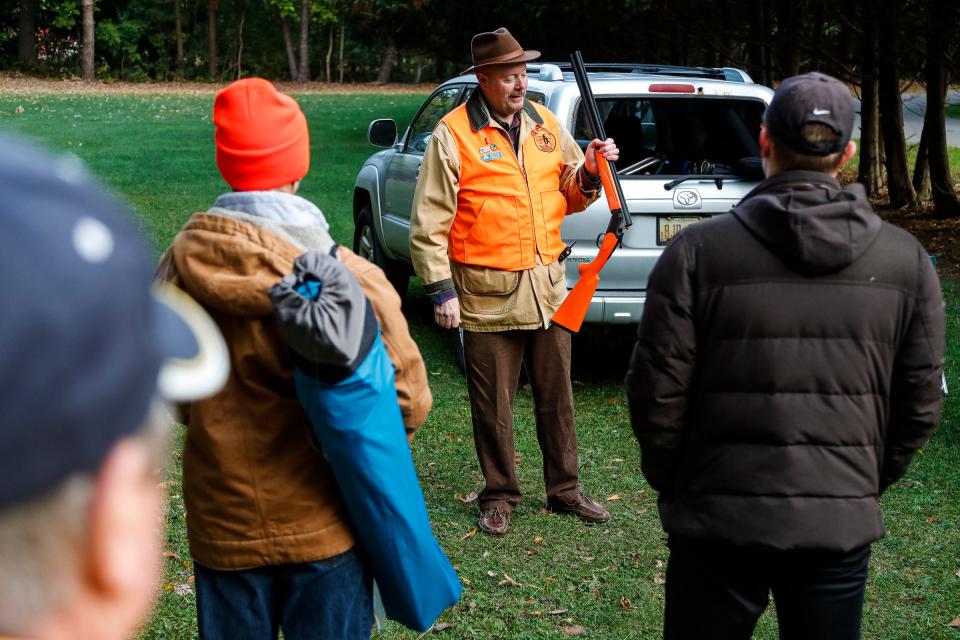Warmer winters, fewer hunters have Michigan deer numbers soaring — and it's becoming a problem
Gloria Hardy thinks whitetail deer are beautiful. But she's under siege from them.
Hardy lives in The Ravines subdivision in Southfield, near a tributary of the Rouge River. Deer love the ravines in the watershed, and come out of them daily to browse in the residential neighborhoods nearby — in ever-increasing numbers.
"They are so detrimental to our shrubbery, our landscape," Hardy said. "I have replanted so many times, trying to find something they don't like. And it's hard to do."
Hardy said she has counted 17 deer in her yard at a time. The deer seem to especially love her arborvitaes — tall, thin evergreens used for privacy.
2 million deer in Michigan — and increasing
"The deer eat them up as high as they can reach — and they sometimes get on their hind legs," she said. "I've planted four sets, and that's $90 a tree now."
Michigan's deer herd is flourishing, and it's becoming a problem. The herd is estimated at 2 million deer, up 300,000 from a decade ago.
Michigan is the second-leading state for car-deer accidents in the U.S., trailing only Pennsylvania, and car-deer accidents have increased 6.6% in Michigan since 2012, with 115 of them causing human fatalities. Farmers and orchard growers are seeing rising problems as well. The number of special, out-of-season deer permits granted by the Michigan Department of Natural Resources to address significant crop damage increased 60% from 2014 to 2020.
A warming climate is bringing milder winters to the Great Lakes region, allowing more deer to survive and reproduce in the spring and early summer. And that's happening as Michigan hunters are getting older and increasingly staying home, with not nearly as many young hunters as needed stepping in to take their place in the woods.
"Since 2000, we've lost over 200,000 hunters in Michigan," said Chad Stewart, deer management specialist for the DNR.
More:Climate change is already hurting Michigan's cherry, apple crops — and it could get worse
More:As climate change alters Michigan forests, some work to see if and how the woods can adapt
Southfield seeks voters' views on killing more deer
"We're coming up on a quarter-million people that are not hunting today that were hunting a little over 20 years ago. That's more than some states in the Midwest have to start with, right now," Stewart said.
Outside of hunting, the major population controller for deer in the Lower Peninsula is vehicle collisions, Stewart said.
"No one wants to manage our deer population with the front end of a car," he said.
Michigan has two ongoing diseases persisting in its deer herd: bovine tuberculosis in the northeastern Lower Peninsula, and chronic wasting disease throughout south-central Michigan. Both could potentially spread as deer populations get denser, Stewart said.
The concerns have gotten so acute that a Deer Advisory Council was organized last year by the Southeast Michigan Council of Governments, SEMCOG, which is conducting a survey through Nov. 11 to gauge public opinions on deer and what to do about them. In Southfield, residents are being asked on the general election ballot whether they would support a deer cull, a thinning of the local herd with the resulting meat donated to local food banks and similar organizations.
"We do have a growing deer problem," Southfield Mayor Kenson Siver said. "The community is pretty split. Some will say, 'Oh, I love Bambi. They were here first.' And then I hear from the people pulling their hair out because they have eaten all of their landscaping."
'A perfect recipe for a problem involving deer'
Oakland is the leading county in the state for car-deer accidents, with 1,854 collisions in 2020.
"I was coming home from Livonia going east on Eight Mile, and this deer jumps out in front of me, from the Detroit side," Siver said. "I go to brake, but it's pointless. The doe crossed over four lanes, hopped over the median, then goes over four more lanes and into Southfield."
But a traditional deer hunt just isn't an option in much of Oakland County.
"We have very built-out communities with a lot of density. It's a perfect recipe for a problem involving deer," said Farmington Hills assistant city manager Joseph Valentine.
The deer are also impacting natural areas of metro Detroit, Siver said.
More:Great Lakes heat waves are already causing chaos for fish — with worst to come
More:Michigan Tech student discovers cactus plant in mountains of Michigan's Upper Peninsula
How deer appetites wreck the forest floor
"We had a study done in our nature areas, a controlled study where we fenced off areas and then we left open areas," he said. "What we are finding is that the deer, because there are so many, are eating all of the understory.
"These are nature preserves; you need the growth to replace the dying trees, the trees knocked down in windstorms."
As young trees, wildflowers and plants are eaten, what often fills their place are undesired invasive species, Siver said.
"It's really becoming ecological disorder," he said.
Hunters thin the herd, but hunter numbers are dwindling
Mike Cook estimates he has shot more than 50 deer in a lifetime of hunting with both a bow and a rifle, almost all of them within 5 miles of his hometown of East Jordan, in Charlevoix County in the northwest Lower Peninsula.
"I loved to hunt; I love the woods, I love nature," said Cook, 73. "Just being out in nature is so relaxing, looking at the colors of the trees; watching a partridge or woodcock walk past you when you are sitting still."
But then Cook's wife of nearly 49 years, Helen, had a health scare. And the couple took to the relaxing snowbird life, heading to Arizona in the fall. Cook said he last went hunting Up North in 2014.
"I thought about coming north to hunt again two years ago, but I've developed arthritis in my spine, and can't walk as far," he said.
Baby boomer hunters like Cook have been the lifeblood of Michigan's hunter population. And beginning to lose them as they age out of the pastime is a looming crisis.
More:Michigan man fatally struck by another car after hitting deer
More:5-night deer cull starts on University of Michigan-Dearborn campus
Younger people aren't becoming deer hunters
Hunters aren't just vital for their assistance in controlling deer populations. The U.S. Fish and Wildlife Service in 2015 estimated hunting generates more than $2.3 billion in economic impact in Michigan, including expenses related to food and lodging and $1.3 billion spent on equipment.
In 2011, most deer-hunting licenses in Michigan were bought by men age 50. In 2021, most were bought by men age 60 — as if it was the exact same hunters, just 10 years later.
"If you have a histogram of the age structure of hunters, it's literally like a wave that keeps moving (right)," Stewart said. "Because the same individual hunters keep advancing in age. And you still have that depression behind them that is widening, because we are not getting the recruitment that we need for younger hunters to participate."
In the 1990s, driven by baby boomers, Michigan had 900,000 deer hunters in the woods. By 2030, the DNR expects about half as many. An age cliff looms where almost all of the hunters who have sustained the activity in Michigan for decades are just too old to do it anymore.

Seeing this coming, the DNR has taken extraordinary steps to get more young people involved in deer hunting. In 2006, the minimum age for hunting deer was dropped from 14 to 12. In 2012, the minimum age requirement was removed altogether. None of it has worked. Since 2013, the number of youth hunters has declined 37%.
A COVID-19 bounce saw youth hunters increase 7.6% year over year in 2020. But with the relaxing of activity restrictions, youth hunter numbers have reverted to pre-pandemic trends.
"It's a real challenge to get started with hunting," Stewart said.
Historically, the DNR's recruitment efforts have focused on youth hunters, "thinking they will grow up and you will have this 40- or 50-year history of being a hunter," he said.
"But what our recruitment, retention and reactivation experts have found is, while opportunities for kids should continue to be made available, kids a lot of times can't dictate whether they go out hunting. They need a mentor to go out with them."
The DNR in recent years has begun emphasizing trying to get people in their 20s or 30s into hunting.

More liberal deer hunt rules
"Trying to start a new activity or lifestyle, when you've never had experience over your first 25 years doing that, is a real challenge, and can be overwhelming to people," Stewart said. "I don't know if anybody has really cracked that nut or developed the cookbook on how to make that happen with high frequency."
As deer populations rise and the number of hunters shrinks, the DNR has liberalized the hunt. A Liberty Season in September expanded hunting opportunities for disabled hunters, including from parked vehicles. Bow hunters can now use crossbows — a possible enticement for those who don't have time to practice and sight in a traditional bow. Antler point restrictions have been relaxed in many Lower Peninsula counties. Perhaps most importantly, antlerless permits, once requiring lotteries and limited to a certain area or county, are now universal. An antlerless license can be used anywhere throughout the Lower Peninsula.
"We want people to go out, be successful and not have that additional burden of purchasing an antlerless license just to shoot a doe, because we are concerned about deer population management," Stewart said.
"These are all changes we are making because we are almost a quarter-million hunters less than we were 20 years ago. Hopefully, hunters can understand that. They see this more open-door policy with antlerless harvest, and some of them get upset with it."
The DNR knows the solution doesn't lie with letting hunting enthusiasts take more and more deer.
More:Michigan Appeals Court throws out cleanup order for dioxane plume under Ann Arbor
More:$10.3 billion investment to upgrade Midwest, Michigan power grid for renewable energy

"Freezer capacity is a big thing for our hunters," Stewart said. "We've long understood that the way to manage the population is not to get hunters to take three, four or five deer. It's to try to get hunters to go from zero to one, increasing the success rate for hunters."
Carl Massey, of East Jordan, said the only hunts he has missed were for a few years after he was drafted to serve in the Vietnam War.
"When I was very young, I shot my dad's deer, my grandpa's deer, a couple of uncles' deer. And they played cribbage in the hunting shack," said Massey, who turns 73 in December.
Massey said he probably would have stopped hunting by now, but two of his grandsons, ages 14 and 16, "bugged the heck out of" him to go hunting with them.
"But I do have some other grandkids who are stuck on that cellphone or computer," he said.
Kids model what their elders do, Massey said. If the parents sail, the kids will probably sail. If they ski, the kids will ski. "Not very many parents deer-hunt anymore," he said. "Therefore, not very many children are going to deer hunt.
"I don't know what the future holds. But I do know my children and my grandchildren, as many as I could get into it, we hunted. I showed them how to dress the animal out; I showed them how to process the animal. And then, after processing, how to cook it."
The effect of climate change on deer numbers
The Great Lakes region is warming faster than the rest of the continental U.S. By the 2030s, the Great Lakes Basin is projected to see 15-16 fewer freezing days per year, with that number increasing throughout the century to varying degrees depending on how much greenhouse gas emissions are curbed.
A 2019 study by the U.S. Geological Survey reviewed more than 1,400 scientific research papers looking at climate change's impacts on deer in the Great Lakes region. The consensus: Increasingly milder winters will lead to increased abundance of deer.
"There's a lot of evidence about how severity of winter can affect deer populations — part of what sets their northern range boundaries is how severe winters are," said Sarah Weiskopf, national biodiversity lead for USGS's National Climate Adaptation Science Center in Reston, Virginia.
Deer use more energy to keep warm in colder winters. Food can be more scarce under deeper snow, and movement is more difficult. Exposure to predators such as wolves in the Upper Peninsula is heightened.
"If you are less healthy from having to expend more energy, and you have less food, that impacts both the survival of deer over winter, and their reproductive success in the spring and summer," Weiskopf said.
That dynamic of milder winters helping to grow the deer population is already at play in Michigan.
"In the Lower Peninsula, we do not experience any type of winter kill that's substantial, where it's going to reset or really knock back the deer herd," Stewart said. "But no one wants to see deer starving, or succumbing to hard winters. That's not how we should be managing our deer."
How deer threaten Michigan's beef and dairy herds
The Michigan deer herd has two diseases persisting in it: bovine tuberculosis and chronic wasting disease.
Bovine TB, a bacterial disease, is a concern because infected deer can give it to nearby livestock, and vice versa. That's a big worry for Michigan's beef and dairy industries.
The risk of humans contracting the disease is small, but exists. Bovine tuberculosis transmission from cattle to people was once common in the United States, but has been nearly eradicated by decades of disease control in cattle and by routine pasteurization of cow’s milk. Fewer than 230 cases of bovine TB now occur in U.S. residents, according to the U.S. Centers for Disease Control and Prevention.
Bovine TB has persisted in wild deer for the past 30 years in a hot spot in the northeastern Lower Peninsula, where the borders of Alpena, Alcona, Oscoda and Montmorency counties meet.
"For the past couple of years, we've been hovering at about 2% of the deer coming out of there testing positive for bovine TB, and that has been elevated compared to years past," Stewart said.
In the south-central Lower Peninsula, the disease problem in deer is chronic wasting disease, or CWD — a contagious neurological disease that affects deer, elk and moose. It causes a degeneration of the brain resulting in emaciated "zombie deer" that behave erratically, lose bodily functions and ultimately die.
CWD is caused by a protein called a prion that folds incorrectly and can infect other deer. It is transmitted through direct animal-to-animal contact or by contact with saliva, urine, feces, blood, carcass parts of an infected animal or infected soil. Prions are extremely resistant in the environment and can remain infectious for years.
Chronic wasting disease found in several Michigan counties
According to the CDC, to date no cases of CWD infection have been reported in people. However, some animal studies suggest CWD poses a risk to certain types of nonhuman primates, like monkeys, that eat meat from infected animals or come in contact with brain or body fluids from infected deer or elk. These studies raise concerns that there may also be a risk to humans.
The DNR is finding CWD in wild deer, mostly in Montcalm County and northeastern Kent County, Stewart said. But it has also been found in surrounding counties such as Ionia, Gratiot, Isabella, Clinton, Ingham, Eaton, southern Jackson and Hillsdale. An infected deer was also found in the Upper Peninsula, in southern Dickinson County.
"From a management standpoint, we're focused on trying to limit the spread," he said. "Because we do not have a solution available to us at this time that eliminates that disease from either the deer or the landscape.
"I would anticipate that (CWD) continues to spread and expand in geographic range, and continues to increase where it already exists and is established."
A rising deer population means deer in closer proximity to one another — a recipe for spreading infectious diseases.
"I don't think it's a stretch to say there is an increased likelihood of transmission occurring," Stewart said.
The national deer problem
The DNR's approach for trying to knock back rising deer populations in Michigan is expanding hunting opportunities and opening possibilities to take does.
But what if that doesn't work? Large-scale professional deer culls, or attempts to utilize birth control or sterilization with deer, are almost impossible logistically and too expensive.
"How do you manage a deer herd when there are no longer as many hunters that you can depend on? Where the swell of new fawns in the summer is going to continue to dwarf the fall kill?" Stewart said.
"That is something that is an ongoing discussion with deer biologists right now — not only in our region, but nationally."
Stewart and a colleague are planning to present information on the looming crisis at a symposium in February with wildlife management officials from multiple states.
"We're trying to look ahead 10 to 15 years, and trying to be prepared today for what those changes are going to look like," he said.
"You are asking really tough questions before we have the answers."
For more information on hunting in Michigan and how to get started, go to http://michigan.gov/dnr/gohunting .
Contact Keith Matheny: kmatheny@freepress.com.
This article originally appeared on Detroit Free Press: Michigan deer population soaring due to fewer hunters, warming climate

